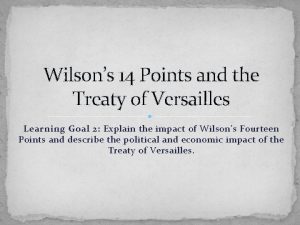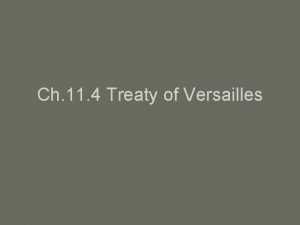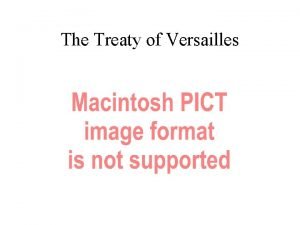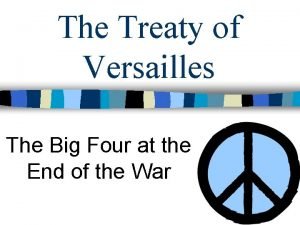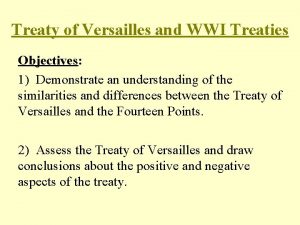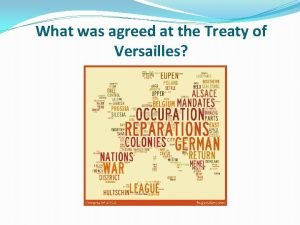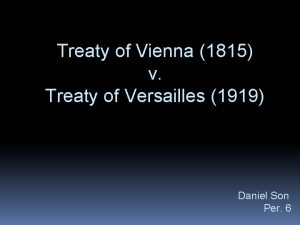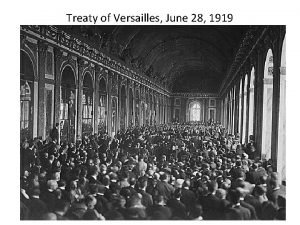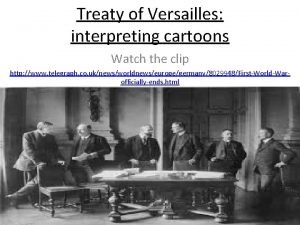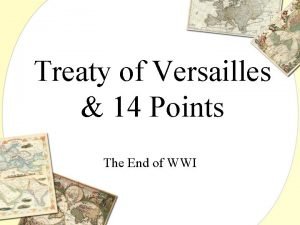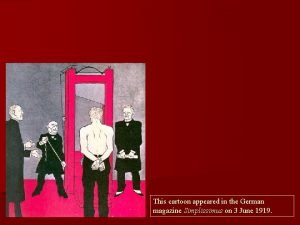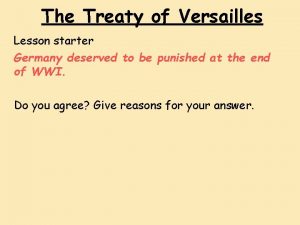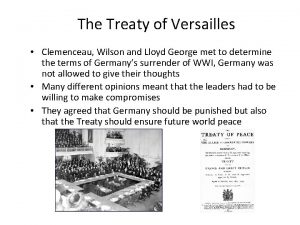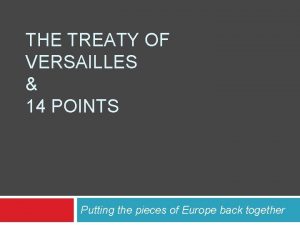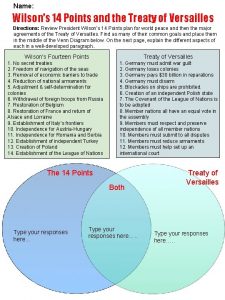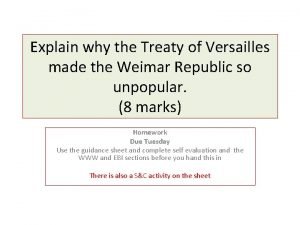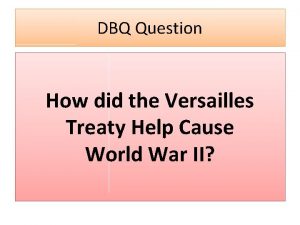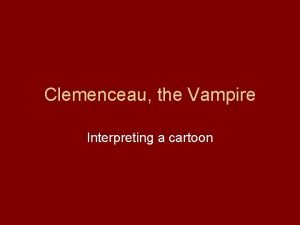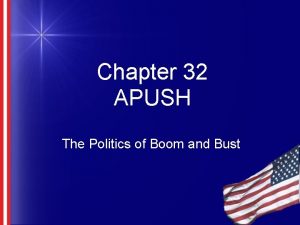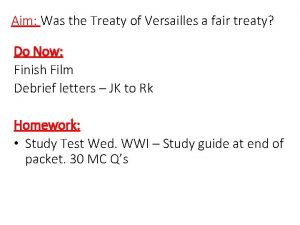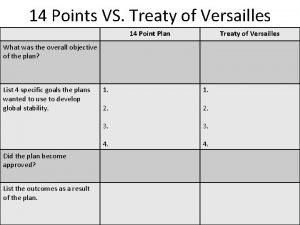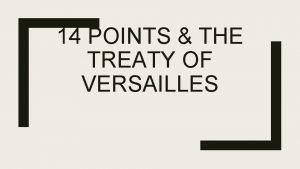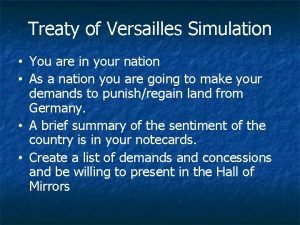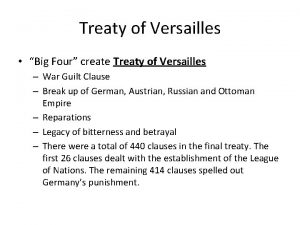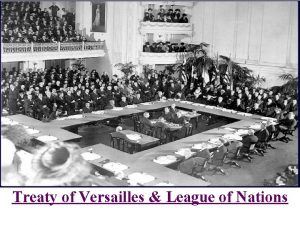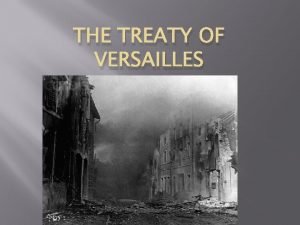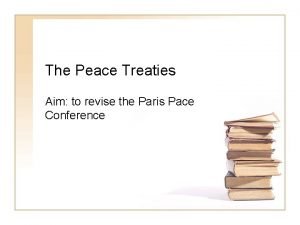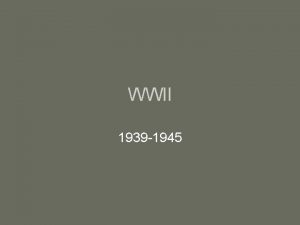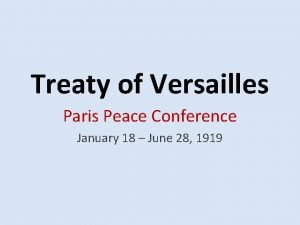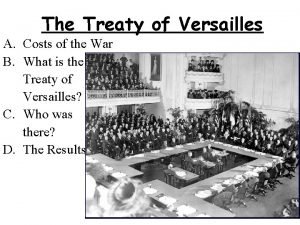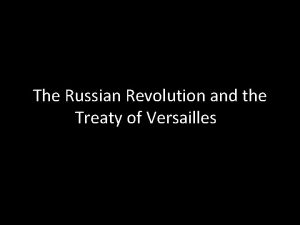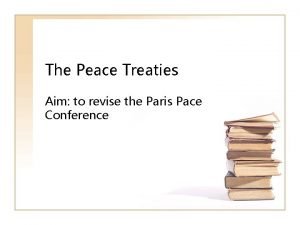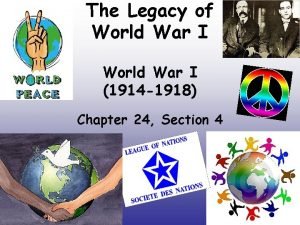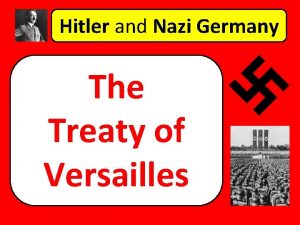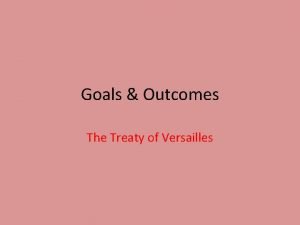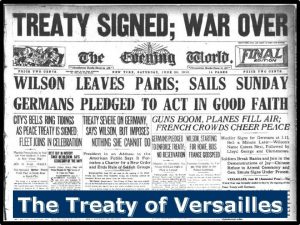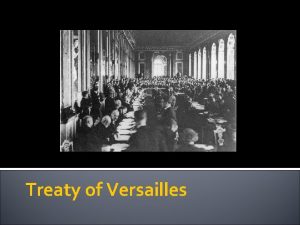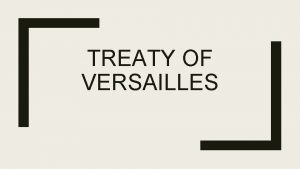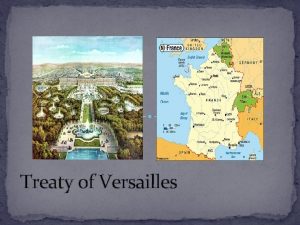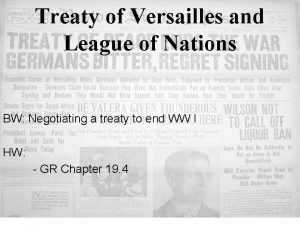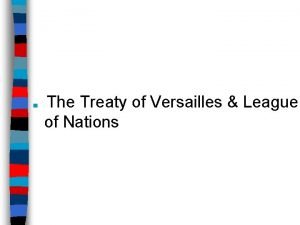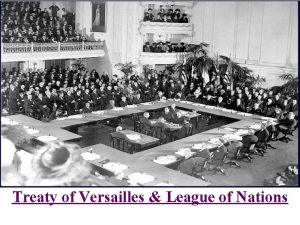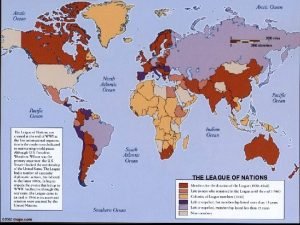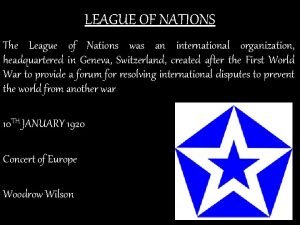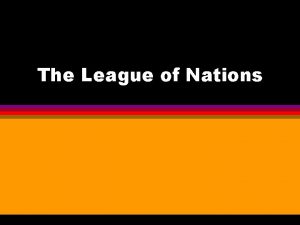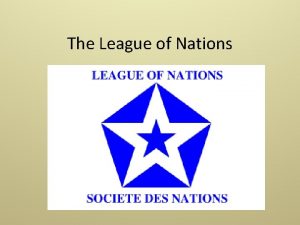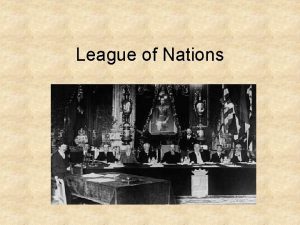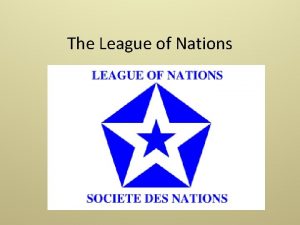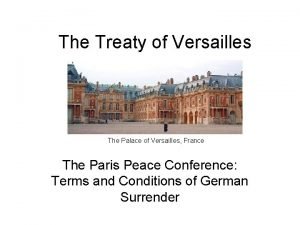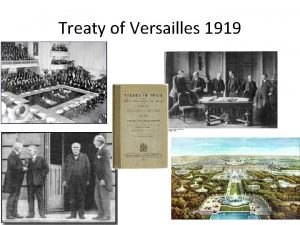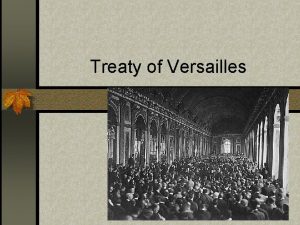Treaty of Versailles and the League of nations







































- Slides: 39

Treaty of Versailles and the League of nations


Woodrow Wilson’s “Fourteen Points” • 10 months before the war’s end, American President Wilson outlined a blueprint for peace. • His program included a plan for free trade, reduction in arms and emphasized selfdetermination. • He also emphasized human rights and a humane treatment of Germany after the war.

The Paris Peace Conference • The Paris Peace Conference opened on 12 th January 1919, meetings were held at various locations in and around Paris until 20 th January, 1920. • Leaders of 32 states representing about 75% of the world's population, attended. • However, negotiations were dominated by the five major powers responsible for defeating the Central Powers: the United States, Britain, France, Italy and Japan. Important figures in these negotiations included Georges Clemenceau (France) David Lloyd George (Britain), Vittorio Orlando (Italy), and Woodrow Wilson (United States).

National interests and the Treaty of Versailles • Each of the Big Four had a different idea about how Germany should be treated • Each had their own agenda and chose to pursue national interests rather than international interests

• France - wanted revenge. – Most of the major battles occurred in France and the country was physically and psychologically devastated. – France wanted to cripple Germany to the extent that they could not fight another war. • Britain – wanted Germany to pay for the damages of the war. – Britain also wanted to secure its colonial interests by limiting Germany’s naval abilities and maintain British naval superiority.







• Italy – Italy began the war as an ally of Germany but traded sides after it was promised land by the allies. The Italians wanted to make sure the land promise was honored. • United States – President Wilson thought that punishing and humiliating Germany was not a long term solution to peace. The American economy would benefit from a strong Germany


The Treaty was a Diktat • A diktat is: – A harsh, unilaterally imposed settlement with a defeated party (www. dictionary. com) – The Treaty of Versailles was a diktat in that Germany was not allowed to negotiate on its own behalf at the Paris Peace Conference and it was forced to accept the Treaty and could not refuse to honor its terms.

Punitive in Nature – The Treaty “Punished” Germany • Six Terms of the Treaty of Versailles • [Memory Word: GARGLE] • Guilt for the War – By clause 231 of the treaty, Germany had to accept the blame ‘for causing all the loss and damage’ of the war.

A rmed forces The Treaty restricted German armed forces to: -only 100, 000 men in the army -conscription was banned – soldiers had to be volunteers -no submarines or aeroplanes -only six battleships -the Rhineland had to be de-militarised


Reparations • Germany had to pay for all the damage of the war in installments, until 1984. • To make these payments, the Weimar Government printed extra money and created a condition of hyper inflation and extreme economic hardship in Germany • A reparations committee determined that Germany owed US $33 billion for the death and damages of the war.

• Article 231 of the Treaty (the 'war guilt' clause) held Germany solely responsible for all 'loss and damage' suffered by the Allies during the war and provided the basis for reparations. • In January 1921, this number was officially put at 269 billion gold marks, a sum that many economists deemed to be excessive. • The economic problems that the payments brought, and German resentment at their imposition, are cited by some as one of the causes of the end of the Weimar Republic and the dictatorship of Adolf Hitler, which eventually led to the outbreak of World War II.

• Canada’s GDP, 2007 = 1, 400, 000, 000 • German Reparations = 000 451, 000, (2007 dollars)

What does $1 Trillion look like • We'll start with a $100 dollar bill. Currently the largest U. S. denomination in general circulation. Most everyone has seen them, slighty fewer have owned them. Guaranteed to make friends wherever they go.


• A packet of one hundred $100 bills is less than 1/2" thick and contains $10, 000. Fits in your pocket easily and is more than enough for week or two of shamefully decadent fun.

• Believe it or not, this next little pile is $1 million dollars (100 packets of $10, 000). You could stuff that into a grocery bag and walk around with it.

• While a measly $1 million looked a little unimpressive, $100 million is a little more respectable. It fits neatly on a standard pallet. . .

• And $1 BILLION dollars. . . now we're really getting somewhere. . .

• Next we'll look at ONE TRILLION dollars. What is a trillion dollars? Well, it's a million. It's a thousand billion. It's a one followed by 12 zeros. You ready for this? It's pretty surprising. Go ahead. . .

And notice those pallets are double stacked.

Germany lost territory • • Alsace-Lorraine was given back to France The Saar coalfields were given to France for 15 years Malmedy was given to Belgium North Schleswig was given to Denmark (after a plebiscite) West Prussia (including the ‘Polish corridor’) and Upper Silesia were given to Poland. Danzig was made a ‘free city’. Memel was given to Lithuania. German colonies were made ‘mandates’ of the League of Nations, to be looked after by France (Cameroons), Britain (Tanganyika), Japan (islands in the Pacific), Australia (New Guinea) and New Zealand (Samoa)


League of Nations • set up as an international forum to settle disputes by discussion, not war. • Germany is not allowed to join initially (until 1926) and the USA eventually refuses to join.

Extra points In addition, the Treaty: • forbade Anschluss (union) between Germany and Austria. • made Estonia, Latvia and Lithuania independent states (in the Balkans).

In all, Germany lost: • • 10% of its land all its colonies 12% of its population 16% of its coalfields half its iron and steel industry most of its army and navy all its airforce.

The League of Nations • The first item on the agenda at the Paris Peace Conference was the creation of a League (council) which was to serve as a means of guaranteeing collective security to all its members. – Collective security means that you rely on the might of the combined group (not one or two individual countries) to ensure and maintain world peace.

A First … • There had been many international organizations before the League of Nations. However, the League was the first attempt at getting all of the world’s countries to gather in a council to discuss and deal with issues. – The League was the world’s first attempt at universal membership in a collective security organization.

United We Stand … • Membership in the League was voluntary and members were required to respect and protect each other’s territories through collective action (working together). – The League would rely on the combined strength of all of its members to make countries think twice about starting a war. – The threat of overwhelming power would prevent any single nation or small group of nations from starting a war that could not possibly be won. – The League hoped that this threat of collective response would make war obsolete.

A Council of the Great … • The League’s most important body was a council of the : great powers” - the USA, Britain, France, Italy, Japan and Russia (were supposed to be permanent members) – as well as non-permanent members elected to fixed terms. • (The USA never took its place and Russia was not admitted until 1934) • Germany was kept out of the League until 1926 but eventually joined as a permanent member of the “power” council.

The Trouble With … • There were several major flaws with the structure of the League of Nations which limited its effectiveness as an agent of collective security: 1. The USA became isolationist in nature (again) and did not join – the world’s most powerful nation was not a member (no BIG STICK). Membership in the League was voluntary. Several countries just “quit” when the League made a decision they didn’t like. The League’s decisions were not “binding” (countries could not be forced to do what the League wanted) since the power on the League rested on “respect” and “agreements” between nation. 2. 3.
 Comparing the 14 points & treaty of versailles
Comparing the 14 points & treaty of versailles Wilson's fourteen points and the treaty of versailles
Wilson's fourteen points and the treaty of versailles The big 4 and the treaty of versailles interactive notebook
The big 4 and the treaty of versailles interactive notebook Us and the treaty of versailles
Us and the treaty of versailles The big 4 treaty of versailles
The big 4 treaty of versailles Fourteen points and treaty of versailles similarities
Fourteen points and treaty of versailles similarities The big three treaty of versailles
The big three treaty of versailles Treaty of versailles 1815
Treaty of versailles 1815 Article 231 of the treaty of versailles
Article 231 of the treaty of versailles Treaty of versailles cartoons
Treaty of versailles cartoons Treaty of versailles terms
Treaty of versailles terms Cartoon in german
Cartoon in german Whats treaty of versailles
Whats treaty of versailles Treaty of versailles lesson
Treaty of versailles lesson Trawl treaty of versailles
Trawl treaty of versailles 14 points vs treaty of versailles
14 points vs treaty of versailles 14 points vs treaty of versailles venn diagram
14 points vs treaty of versailles venn diagram Lamb acronym for the treaty of versailles
Lamb acronym for the treaty of versailles Dbq treaty of versailles
Dbq treaty of versailles Vampire cartoon
Vampire cartoon Reconstruction finance corporation apush def
Reconstruction finance corporation apush def 14 points compared to the treaty of versailles
14 points compared to the treaty of versailles 14 points vs treaty of versailles
14 points vs treaty of versailles Treaty of versailles 14 points
Treaty of versailles 14 points Treaty of versailles simulation
Treaty of versailles simulation Site:slidetodoc.com
Site:slidetodoc.com Treaty of versailles middle east
Treaty of versailles middle east Big four paris
Big four paris Treaty of versailles gargle
Treaty of versailles gargle What year was the treaty of versailles signed
What year was the treaty of versailles signed What year was the treaty of versailles signed
What year was the treaty of versailles signed Treaty of versailles brat
Treaty of versailles brat The treaty of versailles
The treaty of versailles Terms of treaty of versailles
Terms of treaty of versailles Treaty of versailles pictures
Treaty of versailles pictures Treaty of versailles sanhi at bunga
Treaty of versailles sanhi at bunga Treaty of versailles gargle
Treaty of versailles gargle Did wilson want to join the league of nations
Did wilson want to join the league of nations The treaty of versailles
The treaty of versailles Louis xiv goals
Louis xiv goals
